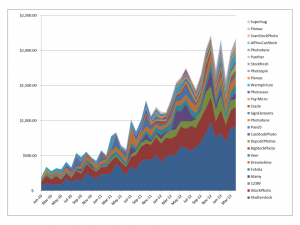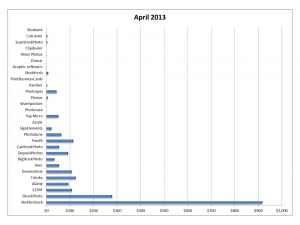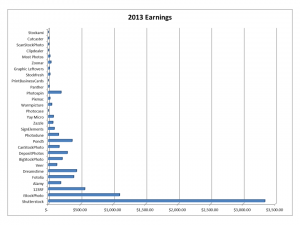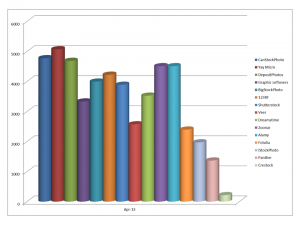Earnings from Stock Photography April 2013
A pretty reasonable month, that puts me back into the $2000+ earning bracket this month – the final total was $2176. Not a best month (that record was set back in November with a total of $2233, but pretty close. What helped this month was a good performance from Shutterstock (aided by a couple of video footage downloads that together $110 – one of which being a skyline pan over Boston, which was probably used in connection with the recent bombing there.) iStock was still in second position with $279, and then I had a number of $100 earners: 123RF, Fotolia, Dreamstime, Alamy and Pond5. It is great how these sites can really make a good month!
Here are the normal graphs:
First, growth in earnings since 2010:
Earnings this month:
Earnings this year:
Files online:
Lets hope that April was the start of a good run of $2000+ months!











Hello, did you ever write something on how to make a footage for shutterstock. I mean, when i made the movie with my NikonD800 camera, in what format do you export the movie and what is the prefered lenght of the movie
I looked back at this – I don’t think I have written anything very useful. That is a pity, because it means that each time I work on some video, I have to try to remember what to do! Couple of things I can recall – I use MPEG_Streamclip to both crop the file for length (you can set the start and end points very easily) and then I use it to recompile the file. I use the PhotoJpeg codec as I recall that is accepted by both SS and Pond5. The container for the file is .mov and I usually end up with a file of about 300M or so. I did go through a very useful course about stock video and posted about that. It is quite expensive, but nicely produced and very clear about some of these issues that we don’t really understand in video.
I have a couple of videos from a recent trip that I need to process. Perhaps this time I will write down the process!
Steve
Can’t thank you enough for the enlightening amount of information you have so gratefully been sharing. The world of microstock photography seems a bit overwhelming.
I had a question about your figures as I am trying to set the right expectations.
I was looking at your top earner shutterstock.
Through April 2013 you show approx. $3400.00 revenue which is $850.00/ month.
You also show approx. 3800 images.
The quick math shows a return then of approx. .22 cents an image per month or $2.64 an image per year.
Does that square?
It seems like an awful lot of work for those kinds of returns considering in time alone you can’t come close to creating an image for less than $3.00, and that would be for an expected 1 year break-even.
Of course that is truly thinking as a business man rather than a hobbyist, but it looks like you got a good system for lining your pockets with a bit of extra dough doing what you love… couldn’t ask for much more than that.
best
Ken
Ken
Thanks for the kind comments – I try to be helpful.
I did an analysis at the end of last year about earnings per online image. That looked at 12 months and all my images across all sites. The average is a little less than $0.70, to give around $8 a year. Shutterstock is normally about 30% of that. Is it enough? Of course, we would all wish for more, but it is one of the great levelling effects of the internet – to make all these images available. I look at it more as creating an ongoing revenue stream – images don’t run out of popularity at the end of their first year. Some become less popular, sure, but others still sell, and will do so after I have stopped uploading (if I do). Hence it becomes a nice residual income stream. I also enjoy photography and travel, and so if I go to Germany (as I did last week) and take 1000 images, I don’t really count my time as a cost of business – I would have gone there anyway as a vacation. However, I do count the hotel, car rental etc. as a cost of my business and claim appropriate costs in my accounts and taxes at the end of the year. I also don’t use paid models or expensive props, so my cost per image in external costs is low. My time is the big cost, and that is where the love of photography comes in. If you don’t like photography, it isn’t a good business. If you would take photos anyway, then you get your great art shots to impress your friends and you get some income as well.
Hope that helps
steve
Steve-
Thanks for the thorough answer and the link to the information that I inexplicably missed.
I agree, seems like its great if you love photography and are doing the work anyway. The longer term notion of some kind of residual income for the hobby is the right mind set.
Continued luck
Ken
Hi,
I would like to do your interview regarding making money through stock photography. Your experience has helped thousands to earn a living of stock. Your blog was an inspiration for me so I started my own http://photoaffiliates.com. I would like to start the interviews section of the blog with yours. Kindly let me know how we can proceed.
Thanks!
I’d be OK with doing an interview – do you want to email me at [email protected]?
Steve